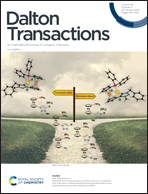A computational investigation of orbital overlap versus energy degeneracy covalency in [UE2]2+ (E = O, S, Se, Te) complexes
Abstract
The extent and nature of covalency in actinide complexes is an important and complex question. There are two main mechanisms of covalency, namely overlap of orbitals or degeneracy of the energies of the ligand and actinide metal, and computational approaches can play a significant part in rationalising the relative importance of each. In this work, we use a suite of computational approaches including Natural Bond Orbitals (NBO), Quantum Theory of Atoms in Molecules (QTAIM) and Interacting Quantum Atoms (IQA) to probe these effects in [E![[double bond, length as m-dash]](https://www.rsc.org/images/entities/char_e001.gif) U
U![[double bond, length as m-dash]](https://www.rsc.org/images/entities/char_e001.gif) E]2+ (E = O, S, Se, Te) and [UE2(H2O)5]2+ compounds. All methods indicate increased bond order and reduced charge separation on descending the group. Donation from filled np orbitals on E into formally empty orbitals on U is evident, with 5f and 6d orbitals the most populated. NBO analysis quantifies orbital interactions, finding energy separation is largest for E = O, while for E = Te the atomic orbitals are almost degenerate. However, NBO and IQA data suggests that although overlap is greater for heavier chalcogens, stabilisation due to covalency is greatest for E = O. Thus, for the heavier chalcogens we find that covalency is driven by near-degeneracy of orbitals involved, which does not stabilise the complexes to the same extent as overlap-driven covalency in uranyl. In the hydrated ions the same trends are broadly reproduced, albeit with more stabilisation and a lower HOMO–LUMO gap. The structure and stability of the [O
E]2+ (E = O, S, Se, Te) and [UE2(H2O)5]2+ compounds. All methods indicate increased bond order and reduced charge separation on descending the group. Donation from filled np orbitals on E into formally empty orbitals on U is evident, with 5f and 6d orbitals the most populated. NBO analysis quantifies orbital interactions, finding energy separation is largest for E = O, while for E = Te the atomic orbitals are almost degenerate. However, NBO and IQA data suggests that although overlap is greater for heavier chalcogens, stabilisation due to covalency is greatest for E = O. Thus, for the heavier chalcogens we find that covalency is driven by near-degeneracy of orbitals involved, which does not stabilise the complexes to the same extent as overlap-driven covalency in uranyl. In the hydrated ions the same trends are broadly reproduced, albeit with more stabilisation and a lower HOMO–LUMO gap. The structure and stability of the [O![[double bond, length as m-dash]](https://www.rsc.org/images/entities/char_e001.gif) U
U![[double bond, length as m-dash]](https://www.rsc.org/images/entities/char_e001.gif) S]2+ ion is also examined, showing evidence for an inverse trans-influence. Finally bending of the [US2(H2O)5]2+ ion has been examined, suggesting a possible meta-stable cis-form.
S]2+ ion is also examined, showing evidence for an inverse trans-influence. Finally bending of the [US2(H2O)5]2+ ion has been examined, suggesting a possible meta-stable cis-form.
![Graphical abstract: A computational investigation of orbital overlap versus energy degeneracy covalency in [UE2]2+ (E = O, S, Se, Te) complexes](/en/Image/Get?imageInfo.ImageType=GA&imageInfo.ImageIdentifier.ManuscriptID=C9DT04484A&imageInfo.ImageIdentifier.Year=2020)


 Please wait while we load your content...
Please wait while we load your content...